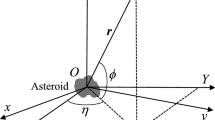Abstract
Station-keeping (SK) is indispensable in actual geostationary (GEO) satellite missions. Due to the luni-solar gravity perturbations, the inclination of a GEO satellite suffers the issues of secular drift and long-period oscillation. Current north-south (NS) SK strategies maintain the GEO satellite’s orbit with high accuracy but low fuel efficiency. In this work, an efficient high-accuracy NS-SK strategy is developed for the GEO satellites. First, an averaging method is employed to decrease the accumulation of the secular drift within a one-solar-day SK cycle, while the long-period oscillation caused by the solar gravity is damped to further improve the orbital accuracy using the impulse and finite-thrust propulsions. Second, we contribute a fuel-optimal cycle that reduces the fuel consumption and a fixed-interval cycle that executes SK control in fixed time interval every day to further enhance the proposed NS-SK strategy. Numerical simulations show that the improved strategy can achieve high-accuracy NS-SK with little fuel consumption. Moreover, results also demonstrate that the fixed-interval cycle can reach higher NS-SK accuracy while consuming less fuel.
Similar content being viewed by others
References
Zou H, Ye Y G, Zong Q G, et al. Imaging energetic electron spectrometer onboard a Chinese navigation satellite in the inclined GEO orbit. Sci China Tech Sci, 2018, 61: 1845–1865
Li H N, Gao Z Z, Li J S, et al. Mathematical prototypes for collocating geostationary satellites. Sci China Tech Sci, 2013, 56: 1086–1092
Lei H. Dynamical models for secular evolution of navigation satellites. Astrodynamics, 2020, 4: 57–73
Li Y H, Yang K Z, Shan C S, et al. A preliminary study on dead geostationary satellite removal. Sci China Tech Sci, 2010, 53: 3389–3396
Sellamuthu H, Sharma R K. Regularized luni-solar gravity dynamics on resident space objects. Astrodynamics, 2021, 5: 91–108
Zhao S G, Gurfil P, Zhang J R. Optimal servicing of geostationary satellites considering Earth’s triaxiality and lunisolar effects. J Guidance Control Dyn, 2016, 39: 2219–2231
Dai X, Lou Y, Dai Z, et al. Real-time precise orbit determination for BDS satellites using the square root information filter. GPS Solut, 2019, 23: 45–58
Soop E M. Handbook of Geostationary Orbits. Dordrecht: Kluwer Academic Publishers, 1994. 3–6
Eckstein M C. Geostationary orbit control considering deterministic cross coupling effects. In: International Astronautical Federation Congress, DLR. Dresden, 1990
de Bruijn F J, Theil S, Choukroun D, et al. Geostationary satellite station-keeping using convex optimization. J Guidance Control Dyn, 2015, 39: 605–616
Eckstein M C. Optimal station keeping by electric propulsion with thrust operation constraints. Celestial Mech, 1980, 21: 129–147
Guelman M M. Geostationary satellites autonomous closed loop station keeping. Acta Astronaut, 2014, 97: 9–15
Weiss A, Kalabić U V, Di Cairano S. Model predictive control for simultaneous station keeping and momentum management of low-thrust satellites. In: American Control Conference. Chicago: IEEE, 2015. 2305–2310
Weiss A, Kalabić U V, Di Cairano S. Station keeping and momentum management of low-thrust satellites using MPC. Aerosp Sci Technol, 2018, 76: 229–241
Gazzino C, Arzelier D, Louembet C, et al. Long-term electric-propulsion geostationary station-keeping via integer programming. J Guid Control Dyn, 2019, 42: 976–991
Wang G B, Meng Y H, Zheng W, et al. Artificial frozen orbit control scheme based on J2 perturbation. Sci China Tech Sci, 2010, 53: 3138–3144
Author information
Authors and Affiliations
Corresponding author
Additional information
This work was supported by the National Natural Science Foundation of China (Grant No. 61273051), sponsored by Qing Lan Project, and the Funding for Outstanding Doctoral Dissertation in Nanjing University of Aeronautics and Astronautics (NUAA) (Grant No. BCXJ19-12).
Rights and permissions
About this article
Cite this article
Huang, X., Yang, B., Li, S. et al. Efficient high-accuracy north-south station-keeping strategy for geostationary satellites. Sci. China Technol. Sci. 64, 2415–2426 (2021). https://doi.org/10.1007/s11431-021-1907-x
Received:
Accepted:
Published:
Issue Date:
DOI: https://doi.org/10.1007/s11431-021-1907-x




